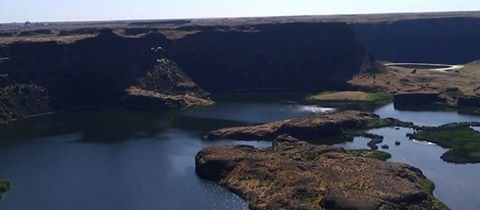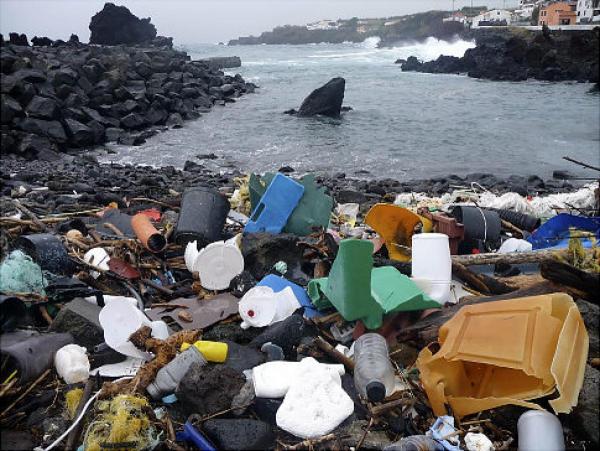 By Matt Remle; Source: Last real Indians
By Matt Remle; Source: Last real Indians
In the beginning was Inyan and Inyan was surrounded in total darkness. Inyan began creation by draining its blood creating a massive disk around itself. Inyan called this disk Maka, the earth, which was half of the disk. The other half was Mni, water. Inyan continued to drain its blood creating Mahpiya, the sky, Anpetu Wi, the sun and daytime, Hanhepi Wi, the moon and nighttime. As Inyan continued to drain its blood life began on Maka with the grasses, plants, flowers, trees and so on.
The last of Inyan’s creation was Winyan and Wicasa, woman and man. Winyan, woman, was created first and created to be like Maka, the earth, to give and nourish life. Wicasa, man, was created to be like the universe to protect and provide nourishment. After creating Winyan and Wicasa, and creation was complete, Inyan became dry and brittle and broke and scattered all over Maka.
The base word of Mni, one of Inyan’s first creations, is ni. The word ni means “to be alive”. Water is life.
Great Pacific garbage patch
Located in the Northern Pacific Ocean lies the Great Pacific garbage patch, also referred to as the Pacific Trash Vortex, and it is a massive patch that is described as a highly concentrated mixture of plastics, chemical sludge and other debris that has become stuck in the currents of the Northern Pacific Gyre. The toxic stew comes from a mixture of trash and debris coming from the coasts of Asia and North America, as well as, debris from cargo ships crossing the Pacific. While the exact size of the garbage patch is hard to determine, estimates range from 5,800,000 sq miles to up to being twice the size of the United States.
The impacts from this toxic debris are especially harsh on marine life as debris from the patch is found in the stomachs of fish, birds, turtles and other aquatic life. The Great Pacific garbage patch also works to block sunlight from reaching algae and phytoplankton, of which the entire marine food web is based on.
The decline in phytoplankton is particularly worry some, in that not only do they help provide the base of the marine food web, but they are responsible for producing half of the world’s oxygen supply. It is estimated by researchers that since the Industrial revolution phytoplankton populations have decreased by 40%.
A similar vortex of trapped garbage debris has also been found in the Atlantic ocean.

Map by National Oceanic and Atmospheric Administration (NOAA)
Dead Zones
A dead zone occurs in the world’s oceans, mainly coast lines, and lakes when oxygen is depleted in those waters to the point that the marine life in those areas dies-off. Dead zones are caused by excessive human pollution. Dead zone’s are particularly prevalent on the Eastern coast of the United States, as well as, the coasts of Europe, China, Japan, New Zealand and South America.
The Gulf of Mexico, off the coasts of Texas and Louisiana, hosts the world’s largest dead zone with estimates ranging to being larger than the state of Connecticut.
Dead zones have also been found off the coast of Oregon, St. Lawrence River and Lake Erie.

Map of Aquatic Dead Zones
KXL Pipeline
If constructed, the Keystone XL pipeline would cross two major aquifers, the Ogallala and the Texas Carrizo-Wilcox. The Ogallala aquifer is the largest in the western North America region. The Carrizo-Wilcox aquifer provides drinking water to roughly twelve-million people in Easter Texas. Construction of the KXL pipeline threatens the possibility of water contamination in these regions due to possible leaks, ruptures, or other activity.
Tar Sands
Fresh water plays an essential role in the development of the oil sands process. In 2010, averages of 3.1 barrels of fresh water were needed to produce 1 barrel of oil sands. Over the course of a year the amount of fresh water used averages 170 million m3 per year2, which is roughly over 40% of the City of Toronto’s total fresh water consumption per year.
Fresh water used for Tar Sands operations comes mainly from the Athabasca River, home to the Dene and Cree First Nations. In addition to drying up fresh water sources tar sands mining causes massive amounts of toxins to be released in the water supply.

Syncrude Aurora Oil Sands Mine, near Fort McMurray, Canada. (SOURCE: goodcanadiankid.com)
Fracking
Like the tar sands production process, fracking uses huge quantities of fresh water. Highly pressurized water, mixed with chemicals, is injected into shale formations to break up and release oil and natural gases. Once used, the now contaminated water is left in massive open air pits.
In the small town of Barnhart, Texas the double impact of climate change and fracking has literally dried out the town’s water supply. In less than two years fracking companies used over 8 million gallons of fresh water leaving the town dry.
It is estimated that by year’s end another 30 small Texan towns will see their water wells go dry due to fracking.
Coal Exports
The proposed coal exports seek to bring coal from the Powder River basin via rail to the Pacific Northwest where it will be exported primarily to China. The trains will cross numerous rivers, creeks, streams, and lakes where the uncapped coal has the potential to spill and pollute. The largest of the export terminals is proposed for Cherry Point, WA sacred grounds to the Lummi Nation. If built, the massive export terminal would threaten not only sacred sites, but also threaten the entire ecosystem of sea life in the area.

Know water know life, No water no life
Above is but a snapshot of just a few of the ways in which Mni, life, is under assault and or threatened. On a global scale Mni has been under assault due to militarism, corporate activity, toxic waste facilities, nuclear power plants (tens of millions of gallons of nuclear waste has seeped into the ground water at the Hanford Nuclear Power Plant in WA State) and other forms of pollution. It is no cliché to say that water is life and the impacts from its desecration are real. It would seem that of all the issues we, as children on Maka, could agree on is that Mni, water, is sacred and its protection in essential.
We have moved into a time where we must remember who and what we are as children of Maka, as relatives to All Our Relations. The children of profit are stepping up their assault on all life and it is essential that we collectively stand together with our first mother and all our relatives to fulfill our responsibilities to give, nourish and protect all life.
Mitakuye oyasin Wakinyan Waanatan (Matt Remle)











